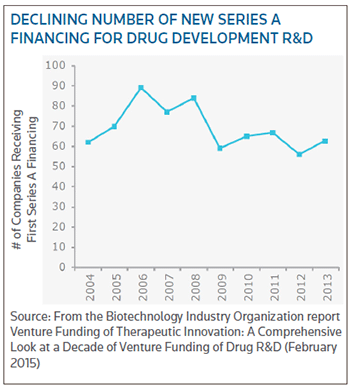
Venture capital flowing, but BIO study points to fewer start-ups
25 February 2015
NEW YORK – The Biotechnology Industry Organization's (BIO) first-ever venture capital study, which analyzed U.S. venture investments during a 10-year period – 2004 to 2013 – turned up several positive trends such as the increasing shift toward biologics and novel drug development, but there was one set of data that gave investors pause. (See BioWorld Today, Feb. 10, 2015.)
 The number of companies closing series A rounds – the financing rounds that essentially launch companies, typically enabling them to get to some proof-of-concept event – declined following the recession. That was expected, but, as of the end of 2013, they had yet to rebound. (See chart, right.)
The number of companies closing series A rounds – the financing rounds that essentially launch companies, typically enabling them to get to some proof-of-concept event – declined following the recession. That was expected, but, as of the end of 2013, they had yet to rebound. (See chart, right.)
That's "quite a striking finding," acknowledged Jonathan Leff, of Deerfield Management, during a session at the recent BIO CEO & Investor Conference. "While most of the metrics tracked here declined after the financial crisis, most have bounced back up" thanks to the "newly resurgent bull market in biotech."
SUPPLY AND DEMAND
But the one that hasn't is the number of new companies formed. "It reflects a balance of supply and demand," Leff said, which is concerning. "We can't keep doing 60 or 70 IPOs [initial public offerings] per year" plus the continuing flurry of M&A, while only starting a few companies each year, he said.
Leff said he sees the problem as a shortage of capital in the hands of venture firms and a shortage in the number of venture firms set up to create early stage companies. "That is in short supply," he said.
And in a way, that's hardly surprising. The number of venture funds investing in life sciences has shrunk over the last several years. But the truth is, only part of that could be blamed on the recession. Venture funds rely on limited partners, and limited partners need return on investments in order to reinvest, and the biotech industry hasn't exactly been awash in robust returns.
"Clearly, if venture capital had development returns that the LPs that were good enough" to warrant further investment, the industry would have seen that investment, said Robert Kiss, managing director at JP Morgan Investment Management.
In that sense, it's a good move to be investing in fewer companies, he added. That means venture capitalists are being choosy about where to invest funds. "We need to avoid the loss ratio that prevailed during the decade of 2000," Kiss said.
According to BIO's findings, there were 89 series A rounds in 2006. In 2013, there were only 63, though the average amount invested in 2013 approached previous highs. In fact, the report noted, "investment into novel drug R&D reached its highest point in 2013. This also suggests more money per company, as dollars have increased while the number of companies has decreased."
For the 10 years covered by the BIO report, series A rounds pulled in a total of $10.7 billion, or about 28 percent investment from all rounds combined.
A LOW POINT
Interestingly, BIO noted, 2012 was the low point, unusual because by then the rest of the market was on an upswing after the recession. Yet, in 2012, only 55 therapeutics companies received their first series A tranches.
And as hard as it is to believe, early data from 2014 indicate a downtick again, said David Thomas, director of industry research and policy analysis at BIO, even though last year "was a great year in venture capital."
According to BioWorld, U.S. private companies raised a total of $780 million in 56 deals in 2014. That was down from the $823 million from 57 deals the year before. (See BioWorld Today, Jan. 5, 2015.)
"The data just confirm what a lot of us have already felt," said Jean-Francois Formela, partner at Atlas Ventures, referring to the shrinking of funds dedicated to biotech investment.
What might have made the numbers fall less dramatically was the rise in corporate venture financing, which stepped in when some of the traditional venture funds bowed out.
"A lot of us looked to corporates [corporate venture] as the place that was going to save the ecosystem," said Deerfield's Leff. And what has happened over the last few years is that traditional venture funds have provided less and corporate VCs have increased participation in funding rounds, even early stage rounds.
But what might not be clear from BIO's study, Leff added, is the number of so-called "crossover investors" that have also jumped into the biotech space in recent years. Crossover investors focus their investments primarily in the public markets, but they can participate in private deals. And with public markets so robust, those investors are even more inclined to support private deals, at least for now.
That is "good as long as it continues and we're in a positive feedback loop," Leff said. But, he pointed out, that's the "kind of feedback loop that can turn very quickly."
"The minute the market goes down . . . that flow of capital can turn on a dime," he added. The industry needs more funds that are set up for the "time horizon and mindset" of drug development.
Our news
-
06 September 2024
-
NovaMedica expands its line of products for the treatment of Alzheimer’s disease
22 August 2024
-
Children visited the NovaMedica Innotech pharmaceutical manufacturing facility
14 June 2024
Media Center
-
87% of cancer patients give positive ratings for medical care quality
18 September 2024
-
The Russian market of fillers and biorevitalizers grew by 21% in the first half of 2024
18 September 2024
-
Pharma’s Patient Reach Problem: Billions Still Left Behind
17 September 2024
-
17 September 2024